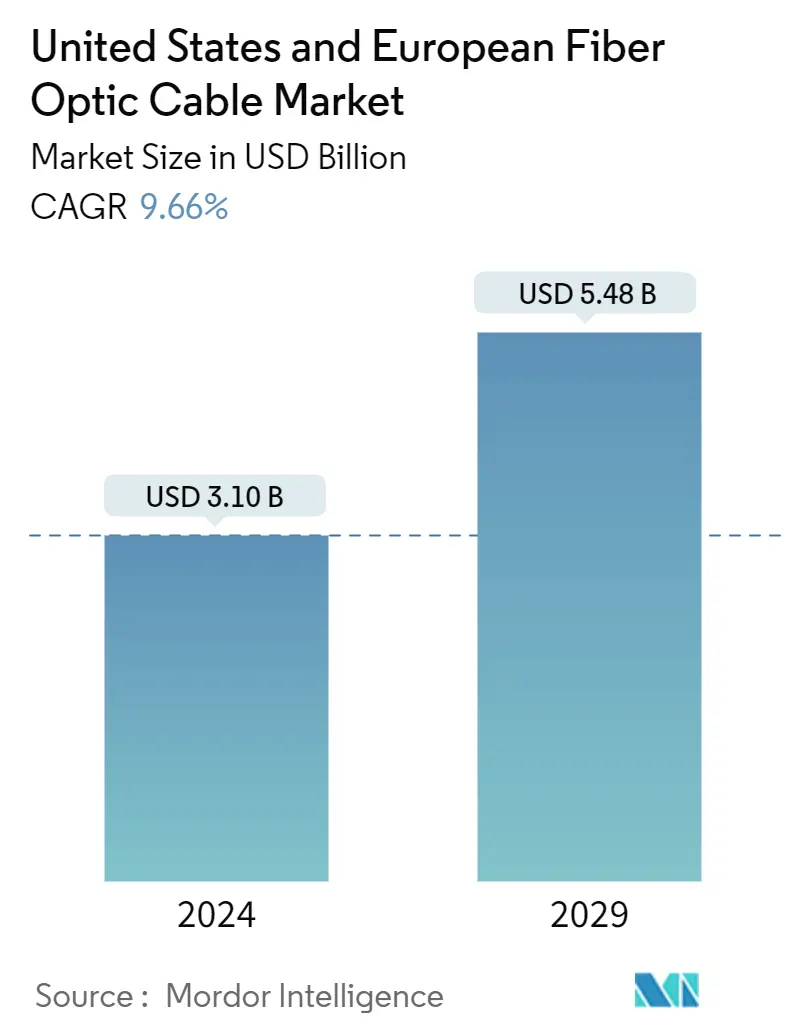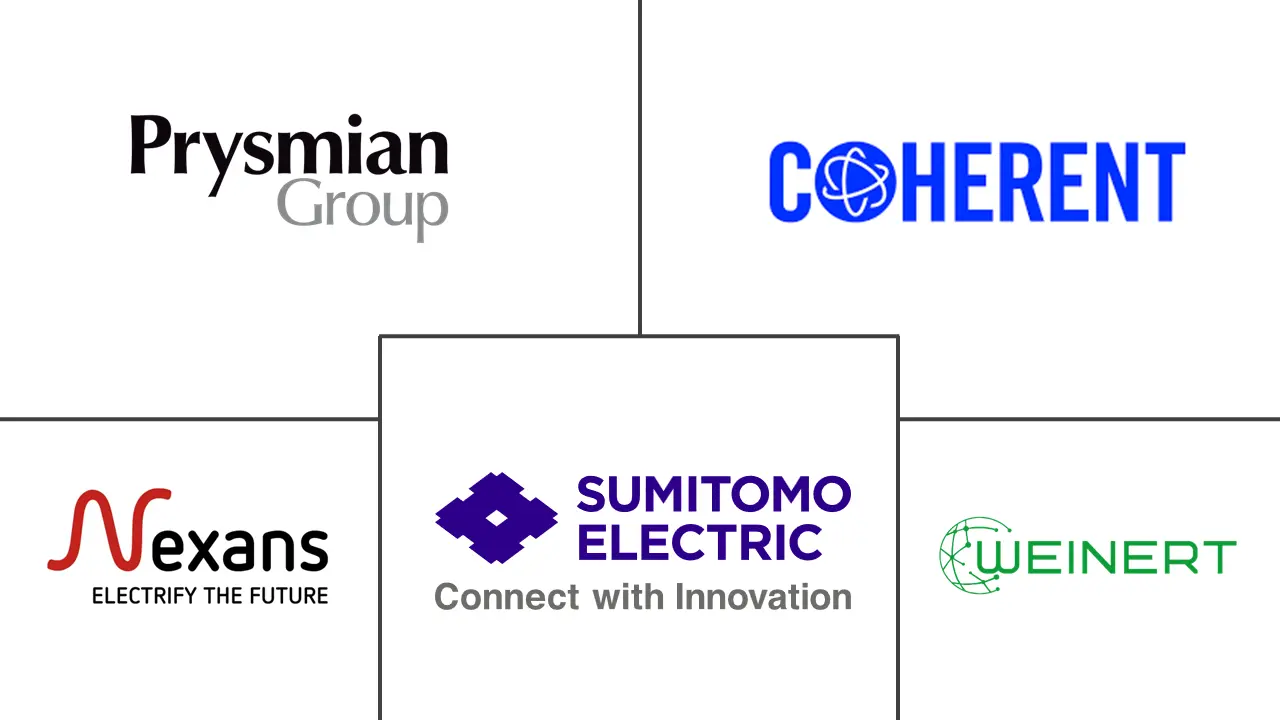Market Size of United States And European Fiber Optic Cable Industry

| Study Period | 2019 - 2029 |
| Base Year For Estimation | 2023 |
| Market Size (2024) | USD 3.10 Billion |
| Market Size (2028) | USD 5.48 Billion |
| CAGR (2024 - 2029) | 9.66 % |
| Market Concentration | Low |
Major Players
*Disclaimer: Major Players sorted in no particular order |
US & European Fiber Optic Cable Market Analysis
The United States And European Fiber Optic Cable Market size is estimated at USD 3.10 billion in 2024, and is expected to reach USD 5.48 billion by 2028, growing at a CAGR of 9.66% during the forecast period (2024-2028).
- The evolution of fifth-generation networks & fiber optic infrastructure has driven digital transformation across industries. Optic fiber cable presents better security, reliability, bandwidth, and security than copper cables. The distinction between a fiber optic cable and a copper wire is that the fiber optic cable utilizes light pulses to transfer information down the fiber lines rather than electronic pulses to transmit information through the copper lines.
- With increasing online transactions & virtual meetings, companies need 5G and optic fiber cable to remain competitive. For instance, according to the European Central Bank, online payments share in consumers' non-recurring payments increased to 17% in 2022 from just 6% in 2019. Hence, to support such trends robust infrastructure such as high-speed internet is required which is anticipated to create opportunities in the studied market.
- Furthermore, fiber optic cables are cost-effective, convenient, & easy solutions for numerous industrial applications, like lighting and decorations, data transmission, surgeries, and mechanical inspections. The growing work-from-home & hybrid work model also drives the need for FTTH throughout the United States and Europe.
- Data traffic growth, specifically Internet Protocol (IP), drives the surge in need for high network bandwidth. Prominent service providers registered bandwidth doubling on their backbones every six to nine months. Due to growing internet traffic, bandwidth doubles every 6 to 9 months.
- The expansion of fiber-integrated infrastructure in the US and the European market has also immensely raised the need for fiber-optic cables, particularly in the telecom industry. Fiber-optic networks and fiberoptic wires have also greatly improved owing to broadband installations. These architectures include FTTH, FTTP, FTTC, & FTTB.
- The increase in the need for connectivity in developing nations for fiber-optic producers offers significant business prospects. Yet factors like the advancement in wireless solution demand & the difficulty of deploying fibreoptic cables provide several operational difficulties for the market's growth.
- Macroeconomic factors also influence the studied market's growth significantly as both the United States and the European regions have been witnessing economic downturns post-covid. Furthermore, geopolitical issues such as the Russia-Ukraine war, and the US-China disputes also creates a challenging environment for an uninterrupted growth of the market.
US & European Fiber Optic Cable Industry Segmentation
Fiber optic technology transmits data by highly flexible, transparent extruded glass or plastic fiber. Fibre optic cables incorporate glass threads as thin as human hair, sending messages modulated into light waves. Although these cables are made of glass, they are highly durable and malleable.
The United States and European Fiber Optic Cable Market is segmented by end-user industry (telecommunication, power utilities, defence/military, industrial, and medical) and by country (United States, Germany, Austria, Switzerland, and the Rest of Europe). The market sizes and forecasts are provided in terms of value (USD) for all the above segments.
| By End-user Industry | |
| Telecommunication | |
| Power Utilities | |
| Defence/military | |
| Industrial | |
| Medical | |
| Other End-user Industries |
| By Country | |
| United States | |
| Germany | |
| Austria and Switzerland |
United States And European Fiber Optic Cable Market Size Summary
The United States and European fiber optic cable market is poised for significant growth, driven by the increasing demand for high-speed internet and advanced telecommunications infrastructure. The transition to fifth-generation networks and the adoption of fiber optic technology over traditional copper cables are key factors propelling this market. Fiber optic cables offer superior security, reliability, and bandwidth, making them essential for supporting the surge in online transactions and virtual communications. The rise of remote work and hybrid models further amplifies the need for fiber-to-the-home (FTTH) solutions. As data traffic continues to escalate, particularly with the expansion of Internet Protocol (IP) networks, the demand for robust fiber optic infrastructure is expected to rise, creating lucrative opportunities for industry players.
The market landscape is characterized by the presence of major telecommunications companies and fiber optic manufacturers, such as Nexans SA, Prysmian Group, and Corning, who are actively expanding their operations to meet the growing demand. Strategic initiatives, including partnerships and technological advancements, are being pursued to enhance product offerings and maintain a competitive edge. The deployment of 5G networks across the United States and Europe further supports market expansion, as fiber optic cables are integral to achieving the high bandwidth and low latency required for modern applications. Additionally, regulatory measures in the European Union mandating fiber optic installations in new and renovated buildings are expected to drive further demand. Despite challenges such as economic fluctuations and geopolitical tensions, the market is well-positioned for continued growth, supported by ongoing investments in fiber optic infrastructure.
United States And European Fiber Optic Cable Market Size - Table of Contents
-
1. MARKET INSIGHTS
-
1.1 Market Overview
-
1.2 Impact of Key Macro-economic themes
-
-
2. MARKET SEGMENTATION
-
2.1 By End-user Industry
-
2.1.1 Telecommunication
-
2.1.2 Power Utilities
-
2.1.3 Defence/military
-
2.1.4 Industrial
-
2.1.5 Medical
-
2.1.6 Other End-user Industries
-
-
2.2 By Country
-
2.2.1 United States
-
2.2.2 Germany
-
2.2.3 Austria and Switzerland
-
-
United States And European Fiber Optic Cable Market Size FAQs
How big is the United States and European Fiber Optic Cable Market?
The United States and European Fiber Optic Cable Market size is expected to reach USD 3.10 billion in 2024 and grow at a CAGR of 9.66% to reach USD 5.48 billion by 2028.
What is the current United States and European Fiber Optic Cable Market size?
In 2024, the United States and European Fiber Optic Cable Market size is expected to reach USD 3.10 billion.

